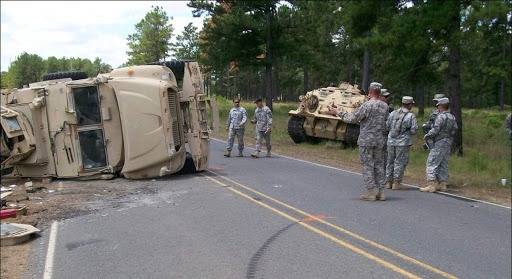In the first quartile of FY2020, a total of five Army personnel were killed in three tactical vehicle rollovers. The year before, the Army lost 13 soldiers to rollover accidents. The Army are not the only service branch to suffer losses of this kind. Marine First Lt. Hugh Connor McDowell was killed in May 2019, when his light armored vehicle (LAV) rolled over into a ditch hidden by thick vegetation. Like the majority of recent rollover fatalities, McDowell was tragically killed during a training exercise. This recent spate of rollover fatalities begs the question, is this problem a new one?
Non-battle injuries and fatalities caused by motor vehicle accidents have been growing in statistical importance since about the mid-20th century. In part, this is because prevention and treatment of disease has reduced the relative threat which sickness poses to deployed forces. However, the increasing motorization and mechanization of the armed forces and uptake of vehicular combat has increased the odds that personnel will be involved in a vehicle accident during their careers.
Signs that more attention should be paid to military vehicle safety should have become apparent in the aftermath of the Persian Gulf War. Between August 2, 1990 to February 28, 1991, transportation related injuries became the foremost cause of non-battle fatalities amongst US forces deployed during the war. 34 percent of the deaths which occurred outside of combat were attributed to motor vehicle accidents (MVAs) and 19 percent of non-battle injuries (NBIs) requiring hospitalization were also the result of MVAs. MVAs were the joint-leading cause of NBIs requiring hospital treatment alongside falls.
A report by the US General Accounting Office’s (GAO) National Security and International Affairs Division shed further light on vehicle accidents between 1988-1996. The GAO found that MVAs accounted for 42 percent of on-duty fatalities in non-aviation accidents, making them responsible for more on-duty deaths than any other type of accident in all the services except the Navy. More specifically, military vehicle accidents were also the leading cause of fatalities in training.
Unfortunately, the statistics prior to the turn of the century do not specify the type of vehicle accidents which took place. It is therefore impossible to determine whether the majority of injuries and fatalities were caused by rollovers, collisions, mechanical failures etc. However, they are useful in examining the broader trend of vehicle accidents in which rollovers are increasingly playing a significant part.
Military vehicle rollovers first began to feature in news headlines in the early 2000’s during Operation Iraqi Freedom (OIF) and Operation Enduring Freedom (OEF). According to Military Medicine Journal findings in 2006, MVAs were the third leading cause of NBIs requiring air medical evacuation in both Iraq and Afghanistan, echoing earlier trends in the Persian Gulf War. Concerns about MVAs in Iraq and Afghanistan coincided with the High Mobility Multipurpose Wheeled Vehicle (HMMWV) up-armoring program which ran between 2003-2005.
A study by the Naval Health Research Center conducted in 2010 found that rollovers were largely to blame for MVAs in Iraq and Afghanistan. Between 2004-2005, rollovers were the cause of 66 percent of MVA fatalities in Iraq. In both theatres of operation, 19 percent of personnel who experienced a rollover were injured as a result, and these injuries were more severe on average than those sustained during other types of MVAs such as collisions.
Military vehicle rollovers persisted as a problem in Iraq and Afghanistan, at first largely with the up-armored HMMWVs and then with the bulky MRAPs which were introduced in 2007 as a more suitable vehicle for counterinsurgency warfare. Yet, in the aftermath of major combat operations in the Middle East, US personnel are still losing their lives in similar accidents.
Although the context in which rollovers are now occurring has changed, many of the conditions present during rollovers in training are comparable to those present during deployment. In October last year, three soldiers were killed during a training exercise when their Bradley Fighting Vehicle (BFV) rolled off a bride and into a stream.
The October accident is comparable to incidents which took place during OIF and OEF. A 2007 study examined 52 incidents of vehicular drowning deaths which took place between 2003-2005 in Iraq and Afghanistan. Two findings stand out in particular; vehicular drowning deaths were almost always the result of a rollover and mostly happened at night. The three soldiers who died in October last year were training in the early morning when their vehicle rolled over at approximately 3:20 a.m. It therefore seems likely that the lowlight conditions impeded their ability to avoid hazards ahead, as was the case for many who were injured and killed years prior in Iraq and Afghanistan.
Of course, this is just one example; but going forward, the Department of Defense would benefit from a comprehensive review of the circumstances which lead to vehicle accidents. A wealth of data exists from Iraq and Afghanistan which could shed light on measures and technology which could be adopted to minimize injuries and fatalities resulting from vehicle rollovers. This will become especially important as US forces reorient training more towards peer-peer conflict and large-scale vehicle maneuver exercises become more frequent.

